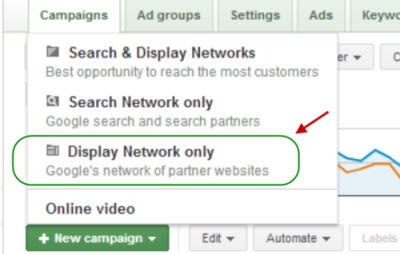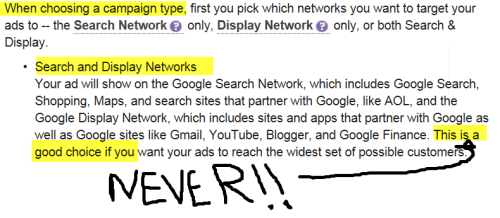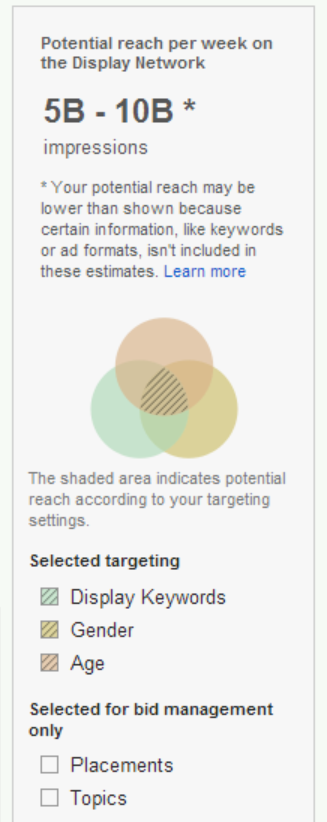A Search Marketer’s Guide To Google Display Advertising, Part 3
Last month, we took a look at the wealth of Google Display Network (GDN) targeting options and explained how they work. This month, I’d like to give you a handful of tips on how to structure your GDN campaigns and ad groups to take advantage of those tactics so you get most out of your […]
Last month, we took a look at the wealth of Google Display Network (GDN) targeting options and explained how they work. This month, I’d like to give you a handful of tips on how to structure your GDN campaigns and ad groups to take advantage of those tactics so you get most out of your display budget.
I like to think about two distinct types of display campaigns which work together but have different goals. The first type is a ‘seed’ campaign, which uses automatic placements to enable our ads to show on every possible relevant webpage across the Internet and which generates conversions at reasonable levels.
The second type is a ‘harvesting’ campaign, which takes the best performing display placement sites from the seed campaign and allows us to optimize them for more conversions and lower costs.
Tip #1: Separate Display From Search Network Campaigns
The most important rule for structuring your display campaigns is to make sure they are Display Network only.

Always create separate Adwords campaigns for the Display Network
Display advertising is very different from search, and enough articles have been written about this point that I hate to even mention it here, except that Google still offers this sort of advice in its online help shown below. (The suggested correction is mine.)

This snippet is from Google help files. The editorial insertion is mine.
For the life of me, I can’t figure out why Google continues to make statements like this. Advertisers who know the difference between search and display advertising know that it is important to manage them separately. New advertisers are particularly susceptible to this sort of poor advice, and I’ve seen way too many ill-informed advertisers blow substantial parts of their budgets on display network ads with absolutely nothing to show for it.
Selecting Campaign Settings
Most of the targeting options you will use for fine-tuning your display campaigns are managed at the ad group level, but you need to select options for Devices, Bids and Budgets, Locations, and Ad Scheduling upfront at the Campaign level.
You’d be surprised at how simply changing from CPM to CPC bidding can change your campaign reach, and profitability; or how differently tablets perform versus smart-phones or desktops; so, once you have your campaigns up and running, you’ll find you want to test different settings for your most important campaigns.
Sometimes your products and services offerings dictate your Campaign settings for you; but in other cases, you’ll have to let the campaigns run for some period of time before you know whether or not to duplicate your campaigns and test different campaign settings.
Tip #2: Manage To Placements
In search campaigns, managing and optimizing the tightest sets of keywords is the ultimate goal for your campaign structure. In display campaigns, your success is all about identifying the best placements and then optimizing to those placements with your targeting options, your ads and your landing pages.
That’s why we generally like to start off with two types of campaigns, one that uses automatic placements, and then another that uses managed placements. With the automatic placement campaigns, we let Google do its best work to place our ads on sites targeted by keywords and topics, and then harvest the best placements into their own managed placement campaigns where we concentrate on optimizing them specifically.
Tip #3: Keep Targeting Simple
When Google introduced its new flexible targeting, it enabled many of the targeting options to be implemented at the ad group level and combined together. You can target keywords, placements, topics, age, gender, interests and remarketing all in the same ad group. In addition, you can optionally specify that some of your targeting options are used to target sites, while others are used only to determine the bid.
For example, if you have a keyword-targeted ad group, and tell Google to show your ads on all eligible placements, not just the ones you specify, then Google will use your keywords to target the site, but your placement bid to determine your actual bid.

This selection means that placements are used only for bid determination.
The more targeting options you layer onto an ad group, the tougher it is to understand what is influencing your performance. In the example below, you’d be hard pressed to know what caused you to win (or not win) a placement.

Combining GDN targeting options gets complex quickly
Although the placement bid is considered the most specific bid, if it was your topic bid that enabled your ad to show, then your topic bid is used. As you can see, it gets pretty complex pretty quickly. There are cases where you will want to attempt this sort of flexible targeting all within the same ad group, but this requires very close attention to detail and painstaking setups.
For a great discussion on how that all works, I recommend you watch this video by my colleague and fellow Search Engine Land author, Brad Geddes, who takes you through the logical hierarchy of flexible reach targeting and bidding logical hierarchy of flexible reach targeting and bidding.
In general, however, we recommend keeping your targeting and bidding separated, and to limit your targeting selections and exclusions to the fewest possible.
Tip #4: Targeting Combinations For Seed Campaigns
The dual purpose of seed campaigns is to expose your ads to the widest reasonable audience at a reasonable cost and to identify sites that have enough impression volume and topical relevance that you want to focus on them in a harvesting campaign.
We find that the best ad group targeting combinations for seed campaigns are:
Keywords + Negative Keywords
Keywords + 1 Topic (or subtopic)
Keywords + 1 Topic Exclusion
We advise against ever running keyword or topic targeting as standalone options. They are simply too unfocussed.
Any of these targeting options will be sufficiently open to allow you to start developing performance profiles for sites you’d like to focus on, and as well, they can bring you good converting traffic from a plethora of the lower volume sites out there on the Internet. Your seed campaigns are not set-it and forget-it, though. You will want to monitor the traffic coming in and fine tune the seed campaigns little-by-little to sculpt the types of sites you are bringing traffic from.
Tip #5: Targeting Combinations For Harvesting Campaigns
Once you’ve identified some good placements from your seed campaigns, you then want to optimize and manage them as managed placements. Again, we recommend that you keep things simple, and isolate only a few targeting options by ad group.
Keywords+ Placements + Negative Keywords
Keywords + Placements + Topics
Keywords + Placements + Topic Exclusions
We typically manage our harvesting campaigns by the keyword theme of the ad group, and manage a few dozen placements inside those ad groups. Over time, however, as we’ve sufficiently optimized the ad groups using these tactics, we will then take the highest volume placements, and move them into their own ad groups, so that we can tailor the color, style and text of the ads to be more integrated with the placement website/webpage, and tweak landing pages for them, too.
Tip #6: Separate Out Your Text And Image Ads
Text and image ads will perform differently on your placement campaigns. We recommend splitting them out into their own ad groups, by image size, so you can easily see which ad sizes perform well on your various placements.
Opinions expressed in this article are those of the guest author and not necessarily Search Engine Land. Staff authors are listed here.
Related stories
New on Search Engine Land